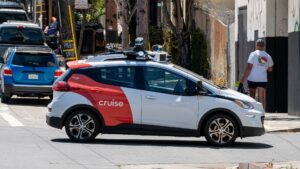GM Shifts Gears: Ending Cruise Robotaxi Operations
An Unexpected Turn for General Motors
General Motors (GM) has been synonymous with automotive innovation for decades, but the recent announcement to cease its Cruise robotaxi operations marks a significant pivot for the company. Under CEO Mary Barra’s leadership, GM aimed to transform from a traditional automaker into a tech-driven powerhouse, exploring opportunities in electric vehicles, autonomous technologies, and even urban air mobility. However, with the dismantling of the Cruise initiative, the narrative takes a new twist.
The Vision vs. Reality
In earlier days, GM presented Cruise as a beacon of future mobility solutions, promoting it as a potential $8 trillion market. Executives forecasted groundbreaking revenues and an impressive valuation for Cruise, estimating $50 billion in revenue by 2030. Fast forward to today, and after an investment of over $10 billion since its acquisition in 2016, GM is folding the robotaxi business into its core automotive operations. This decision underscores a broader corporate realignment in response to an increasingly competitive landscape and the necessity for capital preservation.
Mary Barra has emphasized the importance of focusing on GM’s core operations—software, electric vehicles (EVs), and personal autonomous vehicles. "You’ve got to really understand the cost of running a robotaxi fleet, which is fairly significant, and, again, not our core business," she stated during a recent call with analysts. This notable shift prioritizes sustainable growth over ambitious, yet uncertain, ventures.
Why the Shift?
Several factors influenced GM’s decision to disband its robotaxi sector. While the allure of autonomous ride-hailing seemed to promise untold riches, reality set in as the competition heated up. With rivals like Waymo, Tesla, and even Ford pulling back from similar initiatives, GM began to reassess the viability of its Cruise ambitions. Analysts have broadly recognized GM’s strategy change as a sound financial move—potentially saving more than $1 billion in capital annually. This capital can now be redirected into share buybacks and other growth areas.
Lessons Learned: The High Cost of Innovation
The downfall of Cruise is emblematic of the challenges faced by large corporations striving to innovate. The unfortunate conclusion mirrors past endeavors with technologies that once promised the future but were ultimately shelved, such as the EV1 and Chevrolet Volt. It raises critical questions about GM’s ability to sustain a first-mover advantage in emerging sectors.
Critics assert that Cruise’s downfall wasn’t completely expected. Industry analysts have begun to perceive that investor enthusiasm has waned, as many viewed Cruise as a separate entity from GM’s overall valuation. It seems the holy grail of robotaxis, once a priority, has been overshadowed by GM’s focus on personal autonomy.
What Lies Ahead for GM?
Despite this setback, GM is not abandoning its aspirations for autonomous vehicle technology. Instead, the company’s focus is shifting towards enhancing its Super Cruise hands-free driving system. This technology, which allows for semi-automated driving across various models, has seen a resurgence in interest as GM capitalizes on the advancements in artificial intelligence. With plans to roll out the Super Cruise system to more vehicle models, GM aims to lead the charge in personal vehicle autonomy without the complexity of a robotaxi network.
Navigating the Future
As we look ahead, GM’s strategic pivot raises several critical considerations for investors and industry watchers. The decision to discontinue the Cruise robotaxi service can serve as a cautionary tale about the pitfalls of chasing ambitious growth at the expense of solid core operations.
At Extreme Investor Network, we recognize the complexities of such corporate maneuvers and the broader implications they hold for the automotive industry at large. As GM continues to evolve, we invite our readers to stay tuned for updates and analyses that go beyond the headlines, ensuring you remain informed on industry trends that affect your investments.
In the ever-changing landscape of mobility, the quest for sustainable innovation continues. Will GM’s pivot to Super Cruise set a new standard in driver-assistance technology, or will the challenges of rapid scaling across markets pose unforeseen hurdles? Join us as we navigate this fascinating intersection of technology and transportation.

